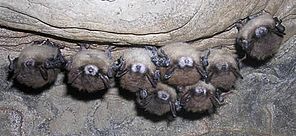Mosquitoes and Bats
August 2009

As dusk settles over Lake Champlain the air begins to hum with life. Those persistent summer pests, mosquitoes emerge from hiding places to chase lovers of the outdoors to shelter.
There are over 40 species of mosquitoes found throughout the Champlain Basin. Some species are weak fliers, never venturing far from where they were born, but one species has been documented as flying up to thirty miles. While most species will happily feast on human blood some restrict themselves to avian prey, and one species concentrates on frogs and other amphibians. Some species breed in any available water; other species require floodwaters and their populations explode during wetter years. Some species breed in the pools of snow melt; and one species’ habitat is restricted to the waters found within pitcher plants.
Mosquitoes are true flies or dipterans. That means they have a pairs of flight wings, and their second pair of wings is small and club-like, used principally for stabilization and orientation. They share the order Diptera with house flies, black flies, gnats, midges and a total of about 124,000 species.
Female mosquitoes use the blood meal we provide to nourish their eggs which they lay in water. (Otherwise mosquitoes feed upon nectar from plants.) Eggs hatch in the water and develop into larvae which can often be seen wriggling away. They filter the water for plant and animal detritus upon which they feed. In turn dragonfly larvae, some plankton species, fish and even other mosquito larvae prey upon the larvae.
Mosquito larvae spend from one to several weeks in the water before becoming adults. The length of time varies based on the species involved, the amount of food available to the larvae, and environmental conditions with warmer weather leading to more rapid development. Mosquitoes may overwinter as adults, larvae, or eggs depending on the species.
As the evening’s hum of mosquitoes begins to grow intolerable, bats begin swooping soundlessly over the water gobbling the insects.
Although the ability of bats to control mosquito populations is often over-stated, they certainly do eat the pests. Bats are mostly opportunistic foragers, seeking to maximize the amount they eat while minimizing the time spent feeding. Thus, they will target large beetles and moths before tiny mosquitoes. Still, a single little brown bat, the most common species in our area, may eat 500 to 1,000 mosquitoes in an hour of foraging, not enough to “control” the population, but certainly fewer for me to swat.
There are nine species of bat known from our area. They range in size from the small-footed bat which weighs less than a nickel to the hoary bat, seven times heavier and with a 16 inch wingspan. All nine species are nocturnal insect feeders, though different species might be more or less active as the evening progresses.
As winter approaches some species migrate to warmer climes before hibernating, while others adjourn to local caves in large colonies. In the last few years, these winter habitats have been the scene of mass bat die-offs.
Bats have been suffering from “white-nosed syndrome” during the winter. The syndrome, first identified in Schoharie County, New York, has been reported or is suspected in nine states from New Hampshire to Virginia. A powdery fungus develops around the noses of infected bats. The fat reserves of the bats decline dangerously, and they often fly around in a desperate search for food that is not there.
Much is still unknown about the condition. It is not clear whether the fungus is a cause of the condition or a secondary response to the loss of the fat reserves. We do not know where it came from or why it has become so prevalent. Studies are on-going to attempt to answer these questions.
In the meantime however, the results are clear. In two years, bat populations have dropped as much as 75% at some hibernacula. "We are witnessing one of the most precipitous declines of wildlife in North America," said Thomas Kunz, director of the Center for Ecology and Conservation Biology at Boston University.
Our friends used to lament the squeaks of bats from beneath their eaves. It now surprises them how much they miss the bats now that the colony is gone. We still have some bats living behind our old chimney and beneath the cedar shingles on the house, but many fewer than in years past. The mosquitoes seem to be thriving though.
Lake Look is a monthly natural history column produced by the Lake Champlain Committee (LCC). Formed in 1963, LCC is the only bi-state organization solely dedicated to protecting Lake Champlain’s health and accessibility. LCC uses science-based advocacy, education, and collaborative action to protect and restore water quality, safeguard natural habitats, foster stewardship, and ensure recreational access.
Get involved by joining LCC using our website secure form (at www.lakechamplaincommittee.org), or mail your contribution (Lake Champlain Committee, 208 Flynn Avenue - BLDG 3 - STUDIO 3-F, Burlington, VT 05401), or contact us at (802) 658-1414, or lcc@lakechamplaincommittee.org for more information.
